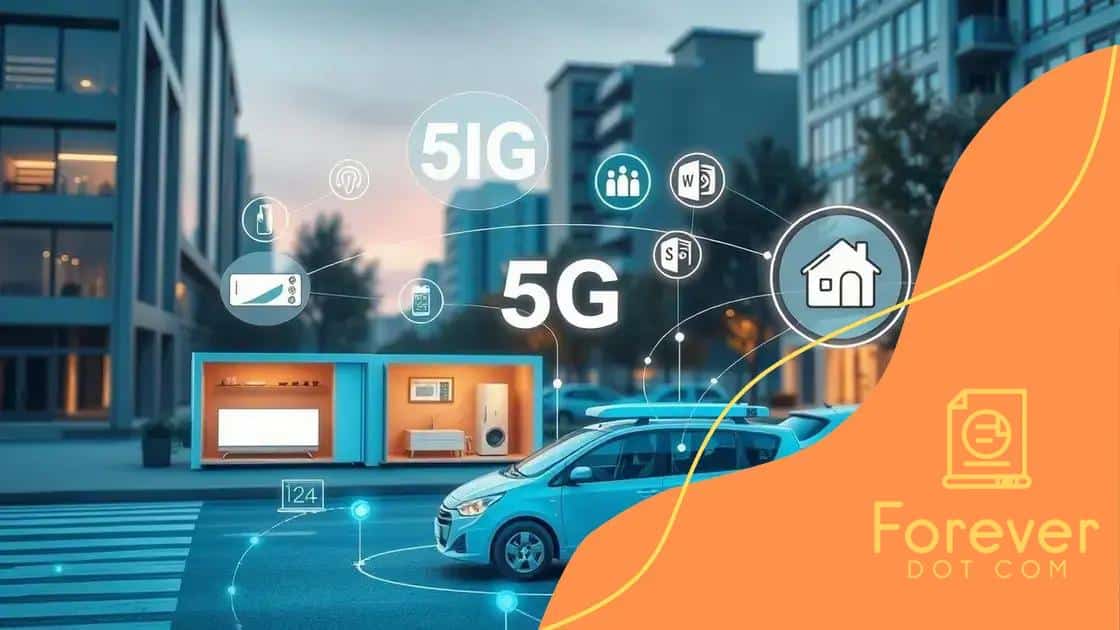How 5G technology is changing global communication networks

5G technology is transforming global communication networks by providing faster speeds, lower latency, enhanced connectivity for IoT devices, and enabling innovations across various industries such as healthcare, transportation, and smart cities.
5G technology is revolutionizing the way we connect and communicate. With its lightning-fast speeds and low latency, how 5G technology is changing global communication networks is a game changer for many industries. Have you considered how this might impact your daily life?
Understanding 5G technology
Understanding 5G technology is essential for grasping how it impacts our world. This next-generation wireless technology enables faster data transfer and a more reliable connection compared to its predecessors. With 5G, users enjoy quicker access to information, enhancing both personal and professional experiences.
What Makes 5G Different?
5G sets itself apart with several unique features that improve user experience:
- Higher Speeds: Users can download large files in seconds.
- Lower Latency: Communication happens almost instantaneously.
- Greater Capacity: More devices can connect at the same time without slowing down.
By utilizing a new radio frequency, 5G achieves unprecedented speeds while maintaining security and reliability. These advancements lead to innovative applications in various sectors, including healthcare, education, and entertainment.
5G and the Internet of Things (IoT)
The integration of 5G with the Internet of Things opens doors to countless possibilities. IoT devices, like smart home systems and connected vehicles, benefit immensely from 5G technology. Because of the higher speeds and capacity, these devices can communicate seamlessly.
Imagine a world where your refrigerator not only cools your food but also orders groceries when supplies are low. This is just a glimpse of what’s possible with 5G.
In addition to IoT, 5G supports advancements in sectors like smart cities, where everything from traffic management to energy usage becomes optimized through real-time data sharing. As cities adopt 5G, the potential for improved living conditions grows exponentially.
Key benefits of 5G for communication
The key benefits of 5G for communication are shaping how we interact with technology in our daily lives. This new technology enhances communication in many exciting ways, making it faster and more reliable.
Speed and Efficiency
The most notable advantage of 5G is its remarkable speed. With 5G, users can expect download speeds that are significantly faster than those provided by 4G. This means that large emails or videos can be downloaded in mere seconds, enabling seamless productivity.
- Instant Downloads: Enjoy quick access to applications and files.
- Stream without Buffering: Experience smooth high-definition video streaming.
- Improved Online Gaming: Enhanced experiences with minimal lag time.
This increased speed allows for better communication between devices, making apps and services more responsive. Whether in urban areas or rural locations, the differences with 5G are evident.
Enhanced Connectivity
Another important benefit is the enhanced connectivity. With 5G, more devices can connect to the internet simultaneously without compromising speed or quality. This is crucial as more smart devices enter homes and workplaces.
Imagine a world where smart refrigerators, thermostats, and security systems all operate without glitches. 5G opens up possibilities for a fully connected environment where data sharing is instantaneous. Technology integration becomes smoother, leading to smarter decisions across various fields.
The technology also supports critical communications, such as healthcare services that require real-time data transmission. For instance, telemedicine solutions can run smoothly, allowing patients and doctors to communicate effectively without interruptions or delays.
By improving connectivity, 5G can enhance collaboration in remote work settings. Teams can share large files and communicate more effectively, leading to increased productivity and better outcomes.
The role of 5G in IoT development

The role of 5G in IoT development is critical to shaping the future of technology. By offering higher speeds and lower latency, 5G acts as a backbone for numerous devices that make up the Internet of Things.
Connecting More Devices
One of the standout features of 5G is its ability to connect a vast number of devices efficiently. This capability is particularly important as more devices are introduced into homes and cities.
- Smart Home Devices: Appliances like smart thermostats and security cameras benefit from reliable connections.
- Wearable Technology: Health-tracking devices can send data in real time.
- Industrial IoT: Factories can utilize connected sensors to monitor equipment and optimize operations.
With the support of 5G, IoT devices can communicate without lag, resulting in a more responsive and interactive experience. This level of connectivity helps not just in convenience but also in enhancing operational efficiency.
Real-Time Data Transmission
The ability to transmit data in real-time is essential for the success of IoT applications. 5G enables devices to send and receive information almost instantly. This is particularly vital in sectors like healthcare and transportation.
In healthcare, doctors can monitor patients remotely, receiving immediate feedback without delays. In transportation, connected vehicles can exchange data with traffic systems, improving safety and traffic flow.
Furthermore, 5G facilitates advanced solutions in smart cities. Traffic lights, waste management systems, and public safety measures can all leverage the Internet of Things to function more effectively. As a result, urban areas can become more livable and sustainable.
The synergy between 5G and IoT not only enhances existing services but also paves the way for innovative ideas. Future applications may include fully autonomous vehicles and intelligent home appliances that learn user preferences, offering unprecedented convenience.
Challenges in deploying 5G networks
The challenges in deploying 5G networks are significant and require careful consideration. As this technology rolls out globally, various obstacles must be addressed to ensure its success.
Infrastructure Requirements
To implement 5G, extensive infrastructure upgrades are necessary. Existing networks may not handle the increased demand for connectivity.
- Tower Construction: Many new towers must be built to provide the necessary coverage.
- Fiber Optic Cables: More fiber connections are needed for fast data transmission.
- Funding: Significant investment is required from telecom companies.
These requirements can delay the rollout in certain areas, particularly in rural regions where geographic challenges exist.
Regulatory and Compliance Issues
Another challenge comes from regulatory hurdles. Government approvals and compliance with local laws can slow down the deployment process.
Operators must navigate various regulations regarding tower placement, emissions, and safety standards. This can cause delays that hinder the timely rollout of 5G services.
Additionally, public concerns about health risks related to increased electromagnetic radiation can lead to opposition against new towers, complicating the deployment process further.
Furthermore, the installation of 5G networks must consider both technical and community issues. Engaging with local communities is essential to address concerns and promote understanding of the benefits of 5G technology.
With the right planning and collaboration, many of these challenges can be mitigated, paving the way for a successful transition to 5G.
Future prospects of 5G technology
The future prospects of 5G technology are incredibly promising, opening up a world of possibilities that can reshape industries and improve daily life. As 5G continues to develop, its impact will be felt in various sectors.
Innovation in Various Fields
One of the key areas where 5G will make a difference is in innovation. Industries such as transportation, healthcare, and entertainment are poised to benefit significantly.
- Transportation: With 5G, autonomous vehicles can communicate with each other and infrastructure in real-time, enhancing safety and efficiency.
- Healthcare: Remote surgery and real-time patient monitoring will become more effective, improving patient outcomes.
- Entertainment: Streaming high-definition content and immersive experiences, like virtual reality, will be seamless with 5G.
This technology will enable new applications that we have yet to imagine, leading to advancements that will enhance productivity and quality of life.
Smart Cities and Infrastructure
The rise of smart cities is another exciting prospect for 5G technology. These urban environments will leverage 5G networks to connect devices across various services.
Imagine systems that manage traffic flow, reduce energy consumption, and improve public safety, all driven by real-time data analysis. With 5G, municipalities can deploy solutions that enhance urban living and reduce costs.
Furthermore, infrastructure maintenance can also benefit from 5G, as sensors installed in roads and bridges can send alerts when maintenance is needed, preventing catastrophic failures and ensuring safety.
Collaboration between governments, businesses, and communities will be essential to realize these prospects fully. By working together, stakeholders can innovate and ensure that 5G technology is deployed effectively and responsibly.
FAQ – Frequently Asked Questions about 5G Technology
What is 5G technology?
5G is the fifth generation of mobile communication technology that offers faster speeds, lower latency, and greater connectivity for devices.
How does 5G impact the Internet of Things (IoT)?
5G enhances IoT by connecting more devices efficiently and enabling real-time data transmission, improving the functionality of smart devices.
What are some benefits of 5G for healthcare?
5G allows for real-time patient monitoring and remote surgery capabilities, which can improve patient outcomes and accessibility.
What challenges are faced in deploying 5G networks?
Challenges include the need for extensive infrastructure upgrades, regulatory hurdles, and public concerns regarding health and safety.






